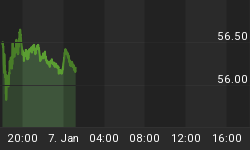Summary
I think something worse -- perhaps significantly worse -- than a mere "healthy correction" is lurking out in the future ... The question of great and growing import now is could the "future" be closer at hand than almost all strategists, analysts, etc. believe it could be?
Over the last several weeks, I've been discussing the possible topping pattern being traced out in the stock market. The following table provides an update, using the seven measures in my tracking group as a proxy.
| SELECTED STOCK-MARKET MEASURES | ||||||
| 03/02 Close | Recent Highs | 02/11 Close | 01/26 Close | 03/02 From 01/26 | ||
| Close | Date | |||||
| NYSE Comp. | 6717 | 6770 | 02/17 | 6751 | 6672 | +0.7% |
| Value Line | 382 | 384 | 03/01 | 384 | 384 | -0.5% |
| S&P 500 | 1149 | 1158 | 02/11 | 1158 | 1155 | -0.5% |
| Wil. 5000 | 11225 | 11293 | 02/11 | 11293 | 11282 | -0.5% |
| DJIA | 10591 | 10738 | 02/11 | 10738 | 10703 | -1.0% |
| Russ. 2000 | 591 | 597 | 02/11 | 597 | 602 | -1.8% |
| NASDAQ 100 | 1473 | 1554 | 01/26 | 1514 | 1554 | -5.2% |
| Average -1.3% | ||||||
| Median -0.5% | ||||||
Prior work identified the closes on 2/11 and 1/26 as possible/probable key levels. Both represented respective highs for most of the measures at the time. As the situation is unfolding, I think it is of more than casual interest that as of yesterday's close, all but the NYSE Composite stood below respective 1/26 closes.
Note in the "Recent Highs" column in the above table that despite the sharp rally during much of this Monday's trading session, the 2/11 levels held. Moreover, the three exceptions, the NYSE Composite, the Value Line (geometric) and the NASDAQ 100, represent interesting stories:
(1) The NYSE Composite limped to a slightly higher high (+0.3%) on 2/17.
(2) The Value Line Index made a very minor high on Monday, but one only a very small fraction higher than the ones established on 2/11 and 1/26.
(3) The NASDAQ 100, the bellwether measure having lost the most momentum recently, has not come close to eclipsing the high it set on 1/26.
Even if the rally commencing off the March 2003 lows continues, it is likely to contain a pullback at some point to around respective 200-day moving averages. At present, this would look like the following, using the DJIA, the NASDAQ Composite and the S&P 500 as benchmarks.
| 200-DAY MOVING-AVERAGE VIOLATIONS -- VALUES PROJECTED FROM CLOSE ON 03/02/04 | |||||||
| Measure | 03/02 Close | MA Violation/ Resulting Price | % Decline From 03/02 Close At Violation Of: | ||||
| 0% | 3% | 6% | 0% | 3% | 6% | ||
| DJIA | 10591 | 9728 | 9436 | 9144 | 8.1 | 10.9 | 13.7 |
| NAZ Comp. | 2040 | 1869 | 1813 | 1757 | 8.4 | 11.1 | 13.9 |
| S&P 500 | 1149 | 1046 | 1015 | 983 | 9.0 | 11.7 | 14.4 |
I think something worse -- perhaps significantly worse -- than a mere "healthy correction" is lurking out in the future. The "how-can-this-be?" explanation of why awaits another time. The question of great and growing import now is could the "future" be closer at hand than almost all strategists, analysts, etc. believe it could be?
As is always the case, the stock market will determine the answer. However, the market's current technical patterns are giving some reason for at least a modicum of concern; it would be damn foolish to ignore them!
In this regard, investors would perhaps do well to reflect back on the distribution pattern the market put in during the first few months of 2002. At the time, the CNBC and related crowd trivialized the hell out of it. The outcome, however, turned out to be anything but trivial!















